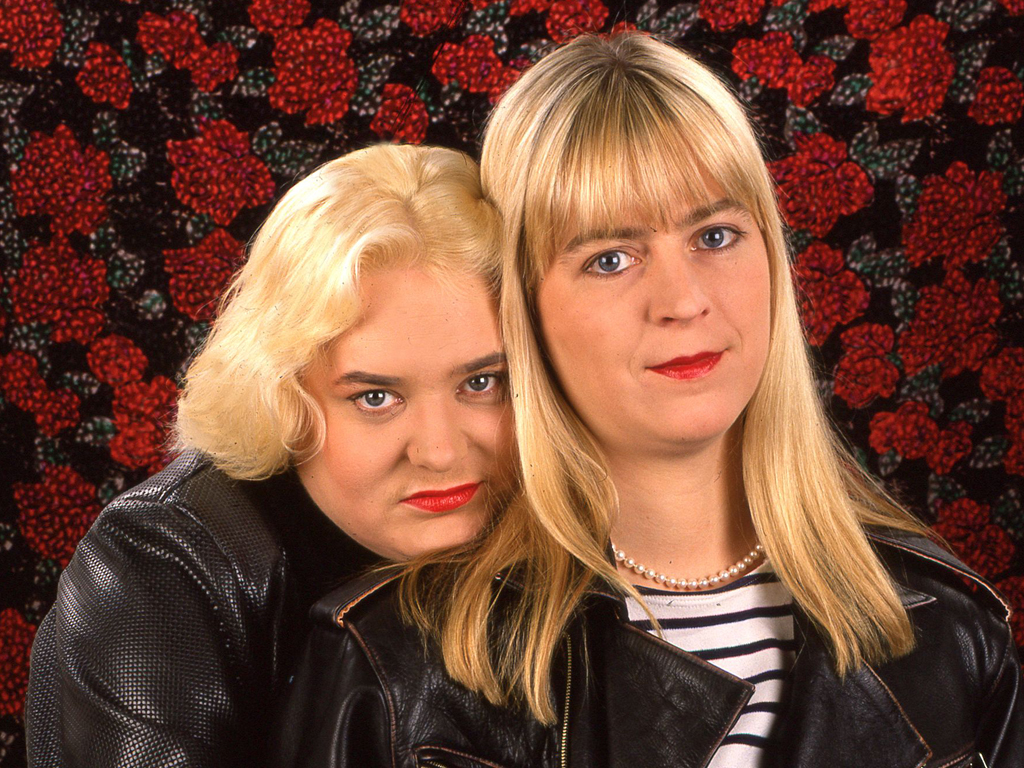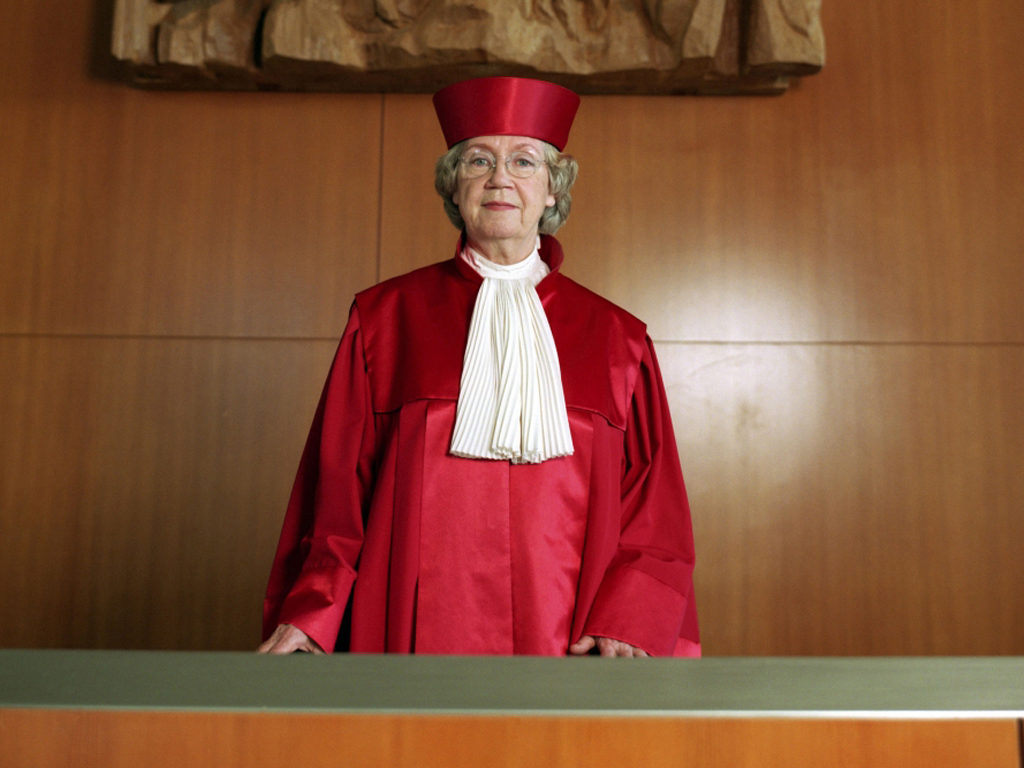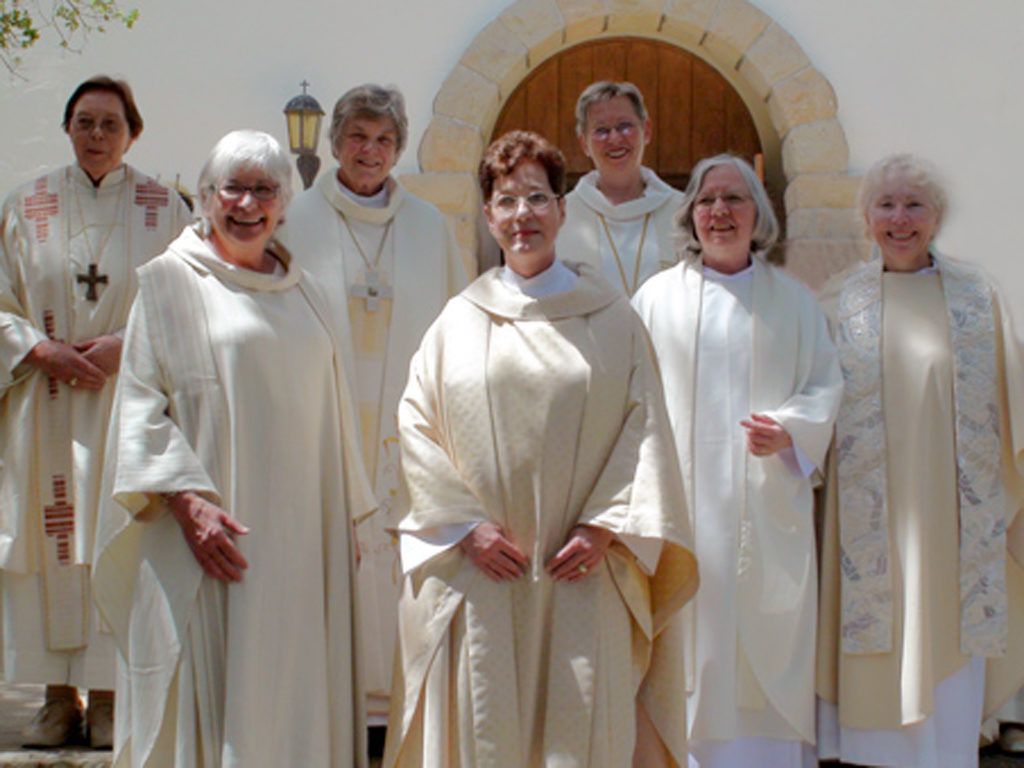Female homosexuality – just like male homosexuality, which was a criminal offence until 1969 – was still a taboo at the beginning of the 1970s. Even within the women’s movement, lesbian women were not visible at first. Nevertheless, the new feminists came under universal suspicion of homosexuality („not normal women!“). With her claim „We were already called lesbians when we did not yet know we were“, the American feminist Robin Morgan put her finger on the following development: that many hitherto exclusively heterosexual women in the women’s movement threw „Zwangsheterosexualität“ or „compulsive heterosexuality“ (Alice Schwarzer) to the four winds and turned bisexual or lesbian. Within the women’s movement in the mid-1970s, tensions broke out between „original lesbians“ – i.e., the minority of homosexual women who were active in the women’s movement – and „movement lesbians“ – i.e., those who first discovered Frauenliebe as feminists.
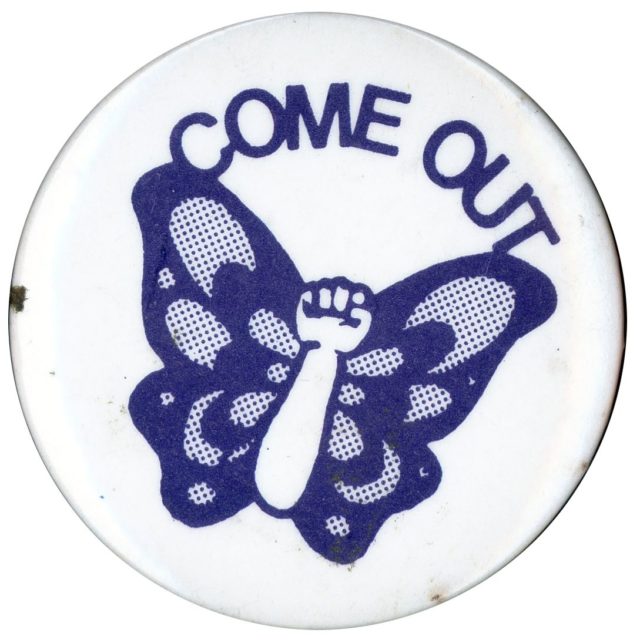
3. July 1971: Rosa von Praunheim’s Entrance
The film Nicht der Homosexuelle ist pervers, sondern die Gesellschaft, in der er lebt1 by Rosa von Praunheim is shown as part of the Berlinale. Half a year later, the film that Praunheim had produced on behalf of the WDR is also broadcast on TV. As a result, numerous homosexual groups are established in the FRG, including the first Homosexuelle Aktion Westberlin (HAW) on 15 August 1971. Homosexual women are active in the HAW, as they are in other groups; however, they are significantly in the minority.2
1 March 1972: Gay Women Form Their Own Group in HAW
![HAW-Frauen : Eine ist keine - Gemeinsam sind wir stark : Dokumentation (1974). - Homosexuelle Aktion West-Berlin Frauengruppe [Hrsg.]. Berlin : HAW-Frauengruppe, S. 1. (FMT-Signatur: LE.11.025) HAW-Frauen : Eine ist keine - Gemeinsam sind wir stark : Dokumentation (1974). - Homosexuelle Aktion West-Berlin Frauengruppe [Hrsg.]. Berlin : HAW-Frauengruppe, S. 1. (FMT-Signatur: LE.11.025)](http://frauenmediaturm.de/wp-content/uploads/2018/07/Cover_HAW_Frauen.jpg)
![Cover Tagungsschrift LAZ: Internationales Lesbentreffen Pfingsten 1972, 1973, 1974, 1975 (1975). - Lesbisches Aktionszentrum (LAZ) [Hrsg.]. Berlin : Selbstverlag. (FMT-Signatur: LE.11.023) Cover Tagungsschrift LAZ: Internationales Lesbentreffen Pfingsten 1972, 1973, 1974, 1975 (1975). - Lesbisches Aktionszentrum (LAZ) [Hrsg.]. Berlin : Selbstverlag. (FMT-Signatur: LE.11.023)](http://frauenmediaturm.de/wp-content/uploads/2018/07/Internationales_Lesbentreffen-480x640.jpg)
Pentecost 1972: National Meeting for Campaigners
The first national meeting of homosexual campaign groups takes place in Berlin. Approximately 30 women and 200 men come together at the invitation of the HAW. After the Pentecost meeting, the second ‘gay women’s group’ in West Germany is created in Hamburg. 8
January 1973: Germany’s First Women’s Centre in Berlin
Germany’s first women’s centre opens in Berlin. Approximately 120 women established the centre at the Hornstraße 2 in Kreuzberg. The main initiators are the women’s group Brot und Rosen and the Frauengruppe der Homosexuellen Aktion Westberlin (HAW).9
With the foundation of the centre, the women of the HAW increasingly detatch themselves from the homosexual men and increasingly collaborate with groups from the women’s centre.
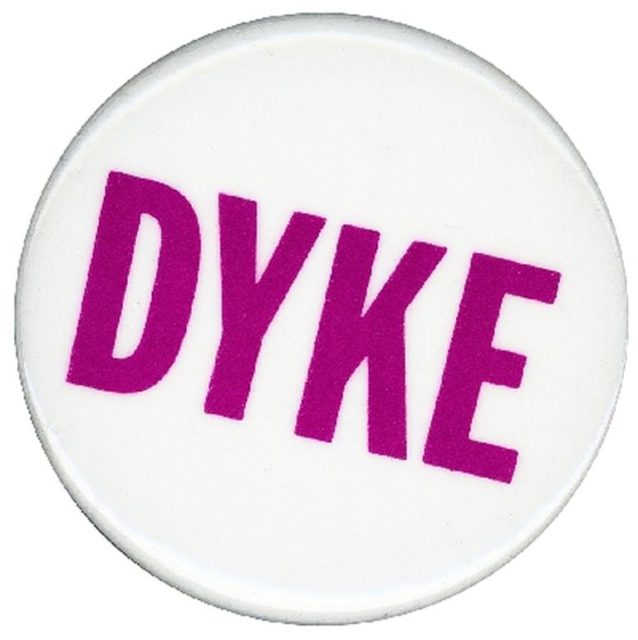
The ARD airs Praunheim’s film, so that homosexual women and men in the GDR (German Democratic Republic) in East Germany are also able to see it. Here, too, it gives impetus to the establishment of the first (private) lesbian groups. The Homosexuelle Interessengemeinschaft (HIB), a semi-public group made up of homosexual women and men, is founded in Berlin.10 At the 10th Weltfestspiele der Jugend und Studenten, homosexual women and men launch a first join campaign. At the final rally in the stadium, they unroll a banner with the inscription: „We homosexuals of the capital greet the participants of the 10th Weltfestspiele and are in favour of socialism in the GDR“.11
Lesbian Life in the GDR
The GDR presents good opportunities for lesbian women because gainful employment is the norm for women, and ‘single’ women enjoy an independent, secure livelihood. Officially, however, lesbians do not exist, and the Demokratischer Frauenbund Deutschlands (DFD) with its 1.4 million members therefore does not tolerate lesbian groups within its ranks. Homosexual women, who – like in West Germany – are initially active in groups together with homosexual men, organise themselves, for the most part, within the broader context of the church.12
In the second half of the 1980s, lesbian women in the GDR also disengage noticeably from gay men and increasingly establish own initiatives. In 1987, lesbian women organise the first GDR-wide lesbian meet-up in Jena.13 By the end of the GDR, eight autonomous lesbian groups exist in various cities. The lesbian magazine frau anders is based in Leipzig.14
17 February 1973: Protest against Murder Trial Ihns/Anderson

For the first time since the beginning of the so-called New Women’s Movement in Germany (‘Neue Frauenbewegung’), homosexual women go public to protest against discrimination and criminalisation. The women’s group of the HAW launches a protest campaign against a series in the newspaper Bild: Die Verbrechen der lesbischen Frauen.15 The reason for the series is the trial of Marion Ihns and Judy Anderson at the Itzehoe district court. The women – who were having an affair – employed a contract killer to murder Ihns’s husband. Both women were victims of sexual abuse in their childhoods; Wolfgang Ihns had not only abused his wife for years, but he had raped her and forced her to have an abortion.16 The court grants the press and public access for the duration of the trial. The trial is accompanied by a lurid media campaign – and not only by the Bild, but by numerous other media outlets („Wenn Frauen Frauen lieben, kommt es oft zu einem Verbrechen“)17 (for more on the trial see the text on law and jurisdiction).
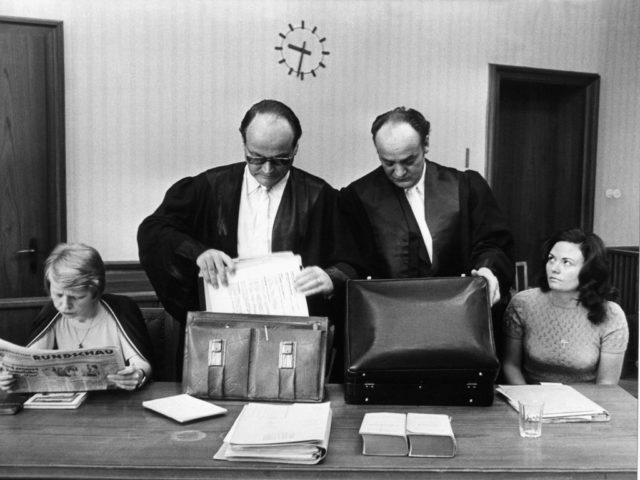
During the trial, women’s groups from across Germany protest in front of and inside the court against the conduct of the case and the media’s smear campaign. In a pamphlet addressing the Bild series, the HAW women declare: „This series wants to implant in readers’ – and especially female readers’ – heads that women who don’t want to accept the role society demands of them as good wives and mothers can only be criminal.“18 In an article for the magazine konkret, journalist Alice Schwarzer writes: „For weeks, the male-dominated press has celebrated turning a murder trial into a lesbian trial.“19 136 female and 36 male journalists lodge a complaint against the defamatory reporting with the Deutscher Presserat, which issues a reprimand.20
30 March 1973: A Call for Lesbian Separatism
The book Lesbian Nation – The Feminist Solution21 by Jill Johnston is published in the USA. The radical feminist defines female heterosexuality as „collaboration with the patriarchy“ and argues for lesbian separatism, i.e. a complete break with the men’s world.22 The book will be published in German translation with Amazonen-Verlag – a publishing house for lesbian literature – in 1977 under the title Lesben-Nation – die feministische Lösung23.
Pentecost-Meeting 1973
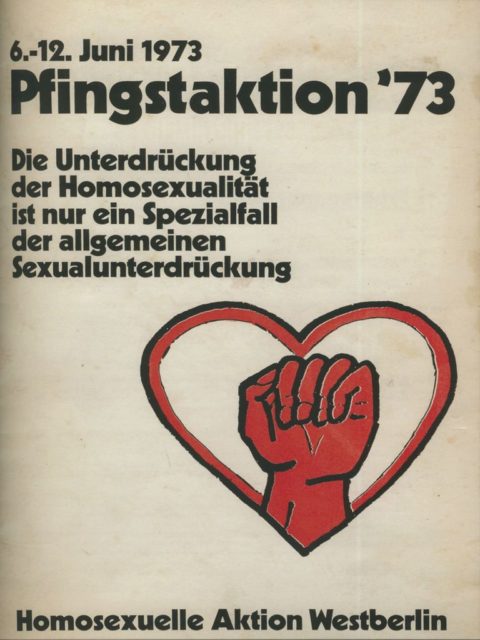
At the HAW’s second national Pentecost meeting, which approximately 50 women attend, the women’s group initiates its own events for the first time. The women establish a working group with the title Von der Notwendigkeit für Lesben, feministisch zu werden and declare: „In our patriarchal society, woman – and the gay woman in particular – is not considered an independent subject able to realise their interests, but she remains an object and a object of desire for men. Gay women need to recognise the role of gender-based roles, to break away from these stereotypes and to take action against them.“24
Summer 1973: The Legendary Island Femø
On the Danish island Femø, feminists from many countries – including many homosexuals – come together for the first time for an international summer camp. The camp, which will also take place the following summer, quickly becomes legendary. The first tensions between the „separatists“ and the „equality feminists“ emerge. The former want to break away completely from male society and retire to a purely female territory. The latter want to continue to influence society and work towards the equality of women and men.25
26 August 1973: Zärtlichkeit und Rebellion
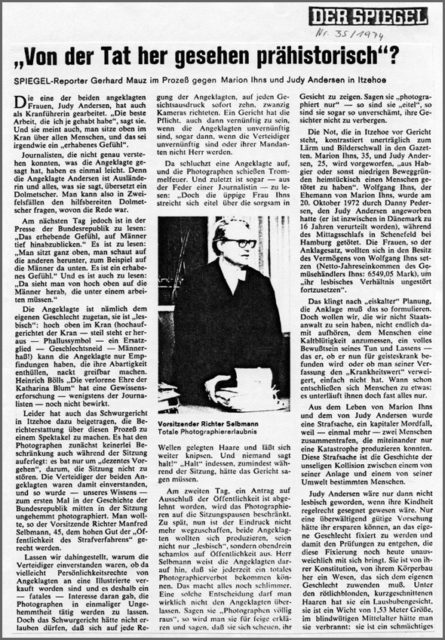
The documentary Zärtlichkeit und Rebellion26 which Eva Müthel had filmed at the HAW’s Pentecost meeting is aired on ZDF. It is well received.27 The weekly newspaper Die Zeit writes: „Even if it has recently been increasingly possible to talk about homosexuality and even if criminal law has taken a more humane starting point, this discussion has always only concerned men – female homosexuality has so far been passed over silently or with barely hidden ridicule.“ Due to the Ihns/Andersen trial and homosexual women’s political awakening, more and more media outlets take up the subject of female homosexuality.28
19 October 1973: Who is afraid of lesbian women?
Nearly 20 women from the HAW and some like-minded men organise a kiss-in at the Ku’Damm in Berlin. The aim is to increase public awareness of female homosexuality, but also to overcome own fears. The group starts at Neckermann and then visits several shops, in which female and male couples exchange „more or less passionate kisses“. The idea for this campaign came from the Los Angeles Lesbian Feminists, who initiated a kiss-in at two public places in Los Angeles on 20 October and called on lesbian groups around the world to stage similar campaigns.29
14 January 1974: More Media Coverage
The TV movie Und wir nehmen uns unser Recht! Lesbierinnen in Deutschland30 by Claus F. Siegfried is broadcast in national television. The women’s group Homosexuelle Aktion Westberlin (HAW) plays a substantial role in its conception.31 The film, which also addresses the discrimination of lesbian women in the workplace, is met with a wide (media) response32. The magazine Stern reports: “Lesbians want out of the ghetto“.33 Further lesbian groups are established.
Pentecost-Meeting 1974
The first Internationales Lesbenpfingsttreffen takes place in Berlin. Motto: „Feminismus die Theorie – Lesbischsein die Praxis?“ Almost 200 women attend.34 Meanwhile, the majority of politically active lesbians had separated from the gay movement and situated themselves within the women’s movement. The HAW women’s group renames itself as Lesbisches Aktionszentrum (LAZ): „As a sign of our independence from homosexual men and in order to express our affiliation with the autonomous women’s movement.“35 The Lesbenpfingsttreffen will continue to grow over the next years and decades; at its most popular, it is attended by up to 1,000 women.36 In addition to a comprehensive programme of workshops and cultural events, demonstrating in new locations is a traditional part of the meeting. In 1991, the Lesbenpfingsttreffen is renamed Lesbenfrühlingstreffen (LFT).37 The meeting still takes place today, each year in a different city.
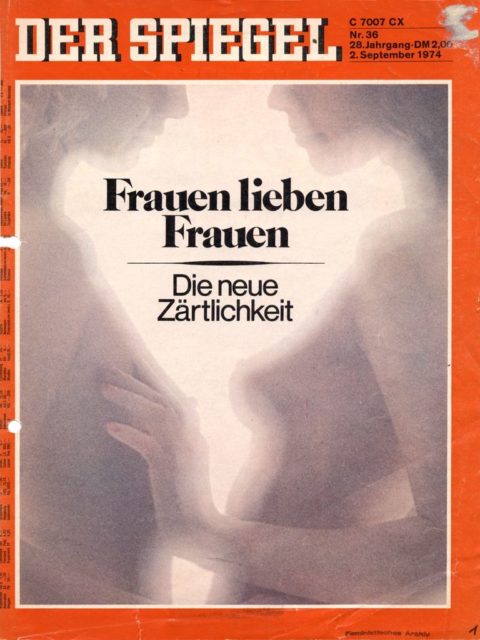
2 September 1974: Women Who Love Women
The Spiegel headlines: Frauen lieben Frauen – Die neue Zärtlichkeit. The magazine thus reacts to the increasing self-confidence of homosexual women as part of the women’s liberation movement. Overproportionally many homosexual women are active within the women’s movement. Over the course of the women’s shared commitment to the cause, some hitherto heterosexual women fell in love with the feminists next door. Out of the „neue Zärtlichkeit“ or „new tenderness“ emerged the „new bisexuality“ or the „new homosexuality“. The Spiegel writes: „One in every four women is, according to Kinsey, aware that she has become sexually aroused by another woman.“
1 October 1974: Verdict of Ihns/Anderson Trial
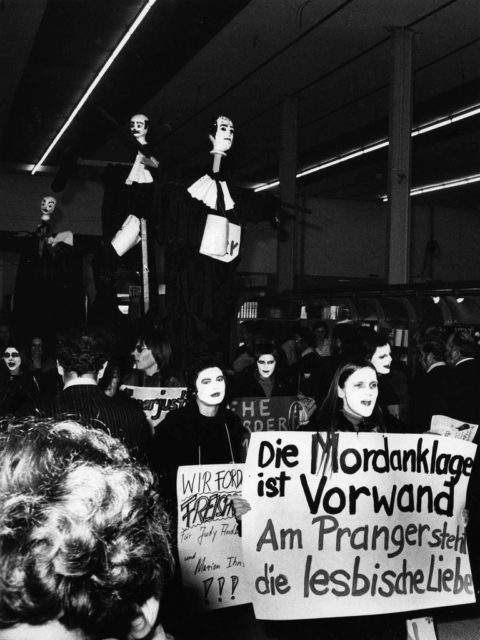
The verdict is read in the murder trial of Marion Ihns and Judy Andersen. Both women are sentenced to life in prison for employing a contract killer to murder Marion Ihns’s husband.38 Afterwards, women’s groups from across Germany demonstrate in front of the court house in Itzehoe. Motto: „The murder charge is just an excuse – lesbian love is in the pillory!“39
15 February 1975: First Lesbian Newspaper in Germany
Unsere Kleine Zeitung (UKZ)40 is published in Berlin as the first German lesbian newspaper since the beginning of the New Women’s Movement. Circulation: 200. The UKZ – which will be issued until 2001 – is published by the group L 74 that was founded in 1974. Initiator is Käthe (Kitty) Kuse. A little later, the Lesbisches Aktionszentrum (LAZ) in Berlin publishes the Lesbenpresse41/42.
![UKZ : unsere kleine Zeitung von und für Lesben. Gruppe L 74 <Berlin> [Hrsg.], 1975. (FMT-Signatur: Z-L301) UKZ : unsere kleine Zeitung von und für Lesben. Gruppe L 74 [Hrsg.], 1975. (FMT-Signatur: Z-L301)](http://frauenmediaturm.de/wp-content/uploads/2018/07/Unsere_kleine_Zeitung-480x640.jpg)
Over the next few years, more and more newspapers are set up also in other cities by homosexual women for homosexual women.
7-9 March 1975: International Lesbian Meeting
The first International Lesbian Meeting takes place in Amsterdam. It becomes the stimulus for the establishment of lesbian groups across all of West Europe.46
July 1975: Against Secrecy
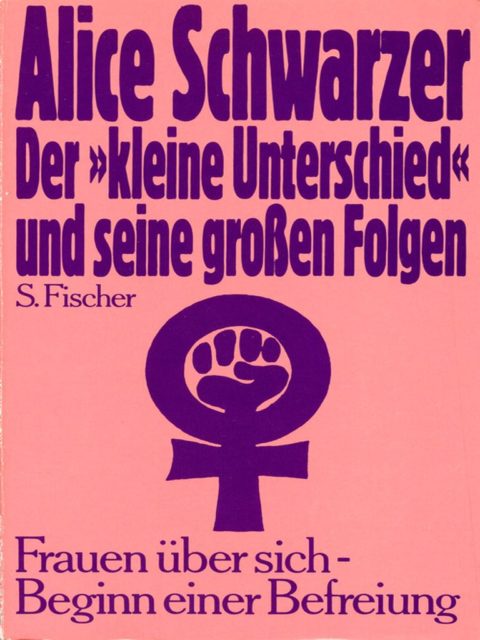
Journalist and activist Alice Schwarzer publishes the report Die Heimlichtuerei macht einen kaputt in the women magazine Brigitte47. Using the example of two homosexual women living in the countryside, Schwarzer describes the destructive consequences of secret homosexuality – and the proud awakening of organised lesbians in the cities. The author assumes that one to two million lesbians live in Germany alone.
September 1975: The „Little Difference“
Alice Schwarzer’s Der „kleine Unterschied“ und seine großen Folgen48 is published. In this book, which soon became a bestseller, Schwarzer interprets the phenomenon of „compulsive heterosexuality“ (a term coined by the psychoanalyst, and contemporary of Freud, Sandor Ferenczi). Schwarzer writes: „Categories like heterosexuality and homosexuality are cultural in nature and not possible to justify biologically. The prevailing heterosexuality is culturally enforced, a compulsive heterosexuality.“ And she argues: „In a culture in which procreation is not the primary impulse for human sexuality, by reason of equal opportunities homosexuality would have to be as self-evident as homosexuality and self love. That this isn’t the case has political reasons. Because only raised to a dogma can heterosexuality ensure the male monopoly on sex – the pretext of which is the ‘petite différence’. This determines the course of the deep dependence and shameless exploitation of women by men in private and in public […]. Women are exploited in the name of love. That’s why sexuality isn’t private, it’s political. And that’s why exclusive heterosexuality is a decisive male instrument of power in the gender struggle.“49
Now, at the very latest, female homosexuality becomes a political issue – and more than a few men feel threatened by the ‘competition’.
April 1976: Lesbian Literature
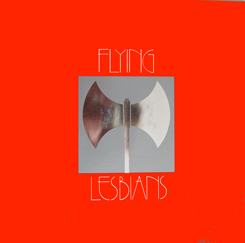
Four women establish the Amazonen-Frauenverlag in Berlin, which wants to „represent lesbian concerns confidently and actively“. This is because the situation of homosexual women is „played down in the media, falsified – yes, even sidelined as ‘pathological’.“ The founders declare: „We no longer want to abandon lesbian literature to existing publishing houses as a ‘spicy’ option for their booklists. We want to publish books, by us for lesbian and women with an autonomous self-image.“50 Jill Johnston’s Lesbian Nation51 and Aimée Duc’s 1901 lesbian novel Sind es Frauen?52 are among the first publications.
The Berlin-based women’s rock group Flying Lesbians, which developed out of the event Rockfete im Rock in 1974, releases its first LP. Distributed by Frauenoffensive, the LP contains the musical setting of the legendary text Frauen gemeinsam sind stark (by Renate Stefan).53

November 1976: Solidarity with Judy Andersen
German women’s groups launch a solidarity campaign for Judy Andersen. Andersen had been held in solitary confinement since her sentencing to life in prison in 1974. The reported reason: the lesbian Andersen might otherwise use the opportunity to engage in sexual contact with other inmates. Andersen, who had already attempted suicide once and was being treated with psychotropic drugs, had – as a Dane – applied for transfer to Denmark and the Danish government had likewise submitted an extradition request.54
Women’s groups protest against the conditions of Andersen’s detention in letters to the Ministry of Justice and the government demanding the extradition of Judy Andersen to Denmark. – Andersen is only transferred to Denmark some ten years later. She receives a pardon within the same year.55
30 June 1979: Christopher Street Day
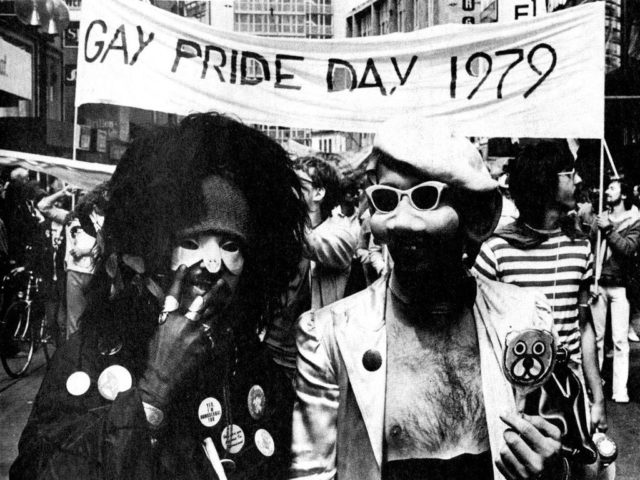
Homosexual women and men take to the streets in Berlin, Cologne, and Bremen for the 10th anniversary of Christopher Street Day.56 On 28 June 1969, gays and lesbians had fought back against a police raid of the homosexual café Stonewall on New York City’s Christopher Street and set off a street fight.57
While ten years later approximately 60,000 lesbians and gays take to the streets of New York in the name of acceptance and against discrimination, in West Germany only a few hundred turn out. Nonetheless, the German protests are the most spectacular demonstration of homosexual self-confidence so far. Even lesbian women make their presence felt.
8 March 1982: Foundation of Lesbenring
The Lesbenring is established as the first national organisation for homosexual women. The goal of the society is „to increase public awareness for the lesbian way of life and promote the equality of this way of life in society“ as well as „to combat the discrimination of lesbian women“.58
October 1982: New Archive in Berlin
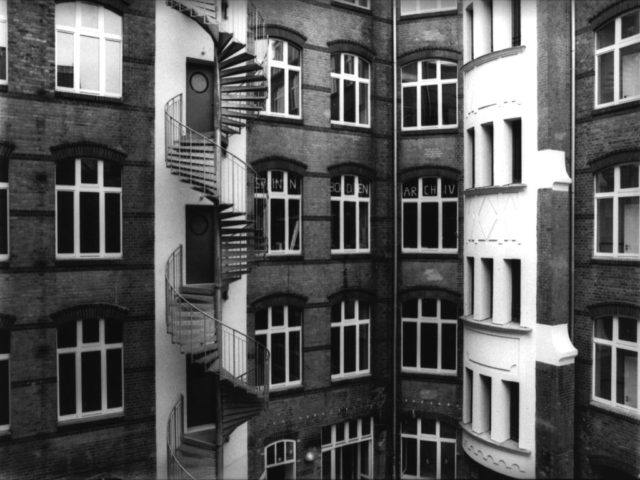
The first archive for publications on the subject of „female homosexuality“ is established: Spinnboden – Archiv zur Entdeckung und Bewahrung von Frauenliebe e.V. The collections of the HAW-Frauengruppe and the LAZ – which starts off with 800 books and 42 folders with newspapers articles as well as journals, pamphlets, and posters – form the core of the archive. Soon thereafter, the archive receives public funding from the Senate of Berlin. Today the archive collection boasts about 14,000 books, journals, videos and DVDS, and posters.59
July 1984: Gay Marriage
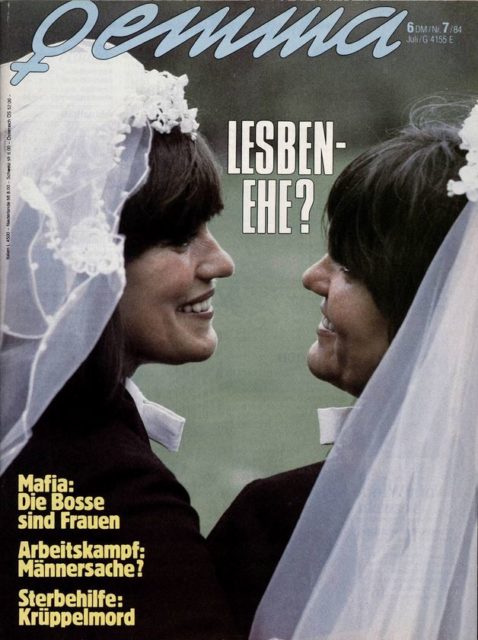
The feminist magazine EMMA headlines with the issue of gay marriage. Under the Title „lesbian marriage?“ EMMA reports about a female couple who – contrary to church ordinance – were married by a pastor from Hamburg. The question mark alludes to the fact that the call for gay marriage is by no means popular among feminists. Marriage is considered a patriarchal instrument of suppression. Therefore, the discussion in EMMA is controversial. The political left is likewise suspicious of marriage because it is „bourgeois“. Alice Schwarzer argues in favour of gay marriage: „That’s why the yearning for marriage, especially in a homosexual relationship, seems to me to be, from an individual perspective, of course completely conformist, but at the same time from a structural point of view downright revolutionary: in a compulsively heterosexual world like ours, it is – and remains – outrageous to take homosexual love as seriously as heterosexual love.“60 ̶
– 17 years later on 1 August 2001, gay marriage comes into force, passed with the votes from the SPD/Green coalition government.
December 1985: Lesbians and the Church
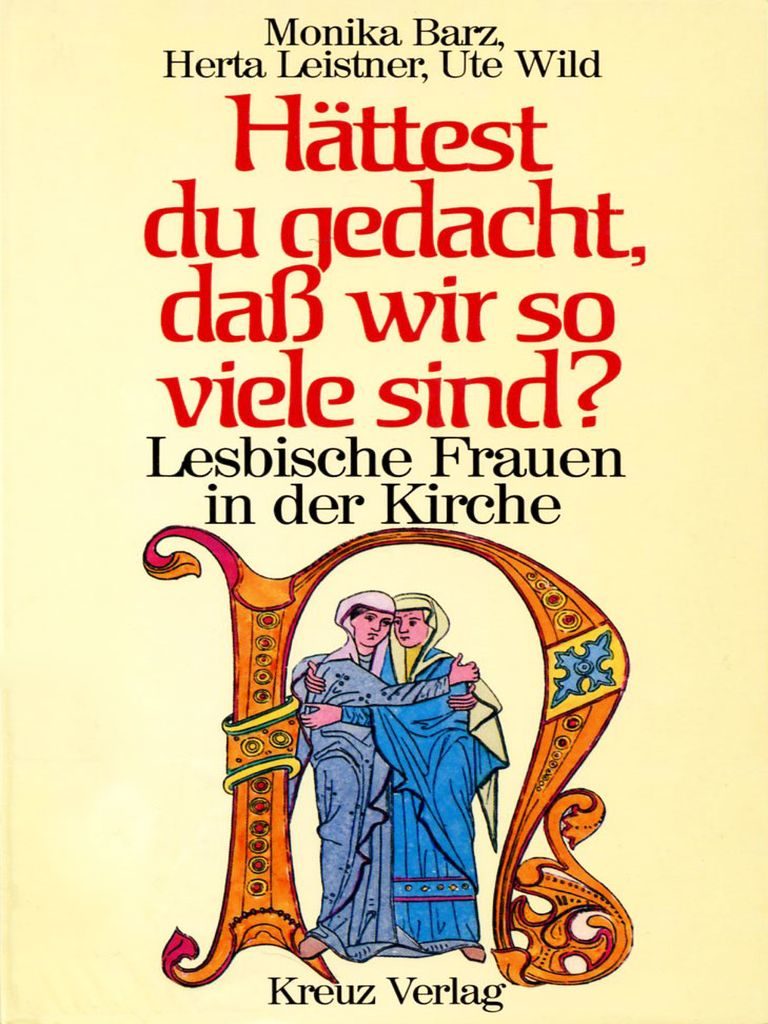
As part of a conference at the Akademie Bad Boll, the network Lesben und Kirche (LuK) is established. The network sees itself as a „union of women who feel differently connected to the faith and the Church, who want to live self-confidently as lesbians of faith, and (…) who criticise the patriarchal form of the Church and of worship and are on the lookout for new forms“.61 The LuK publishes the journal LuK-LekTüre – comprising information, articles, and notices on upcoming events – on a biannual basis. (For more see our text on religion and the church)
In 1987, Herta Leistner – openly homosexual director of studies at the Akademie Bad Boll – publishes Hättest du gedacht, dass wir so viele sind?62 together with Monika Barz and Ute Wild about lesbian women in the church. Leistner becomes a role model for lesbian women in the Protestant Church.
What happens next? Gay Marriage, Lesbian Ministers and the Debate Around Bisexuality
In June 1989, Denmark becomes the first European country to introduce “civil partnership” for same-sex couples, followed by Norway in 1993, Sweden in 1995, and the Netherlands in 1998.63
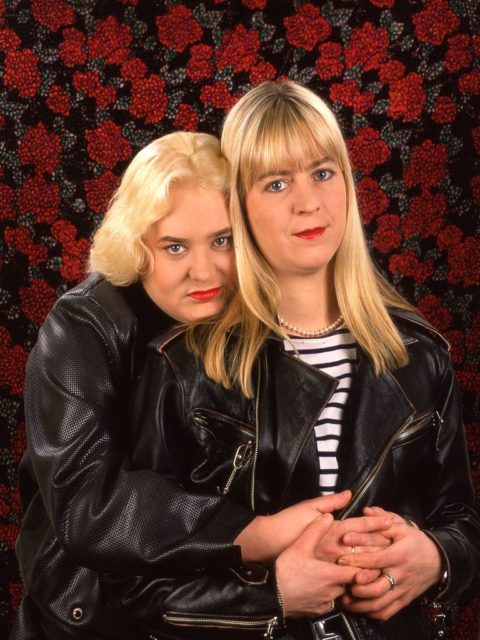
In 1990, the German comedian Hella von Sinnen comes out in spectacular fashion: at the Bambi awards ceremony, Sinnen publicly thanks her “wife Sabine” (her partner at the time, Sabine zur Nieden) and thus makes the front pages across Germany as the first public „lesbian of the nation“. Sinnen is pictured in this photo with her longtime partner Cornelia Scheel on her left. In March 1992, the couple gave an interview to EMMA about their relationship and called for the right to same-sex marriage. – Over the following years, other women – for example, the caberet artist Maren Kroymann or the actress Ulrike Folkerts – come out publicly.64
On August 19 1992, 250 female and male couples from across Germany give notice of their intention to marry, including Hella von Sinnen and her partner at the time Cornelia Scheel, as part of the Aktion Standesamt. The participants protest against the gay marriage ban with this campaign, which receives wide media coverage.65
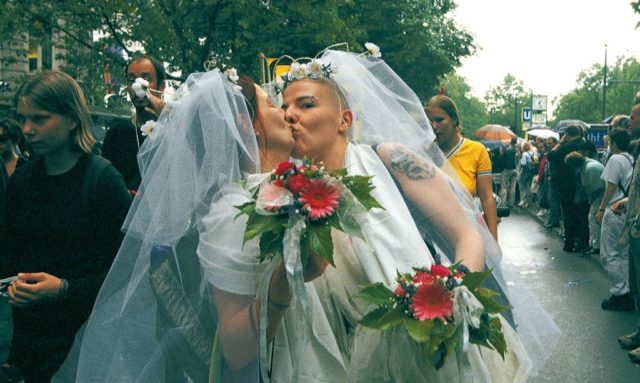
On 10 November 2000, the Bundestag passes the Gesetz zur Beendigung der Diskriminierung gleichgeschlechtlicher Gemeinschaften, in short Lebenspartnerschaftsgesetz (LPartG), with votes from the SPD/Green coalition government. The FDP, which had submitted its own limited draft, votes against the law. The CDU/CSU, which had aggressively spoken out against gay marriage, likewise votes against the law. The law still has to pass in the CDU/CSU-dominated Bundesrat, where (as expected) opponents of gay marriage refuse to give it their approval. The result is a law that only gives same-sex couples rights that are not subject to approval by the Bundesrat: the right to share a common name; the right of residency for a foreign partner; and the right to a small, compulsory portion of the partner’s legacy. A couple is obliged to support each other in case of unemployment or divorce.
In December 2000, the Netherlands becomes the first country to allow same-sex marriage. This means that homosexual couples have exactly the same rights as heterosexual couples, including the right to adopt.66
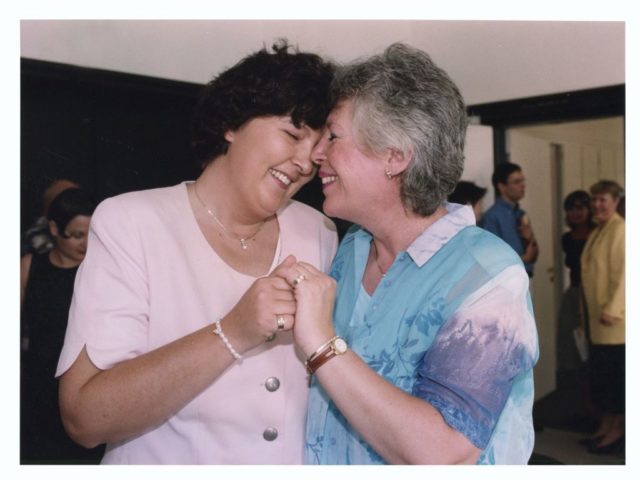
On 1 August 2001, the Lebenspartnerschaftsgesetz comes into force. Across Germany the first homosexual couples enter into „civil partnerships“. The government headed by the SPD/Greens will furnish civil partnership with additional rights in 2004, for example with the right to a survivor’s pension and the right to adopt stepchildren (Gesetz zur Überarbeitung des Lebenspartnerschaftsrechts). From 2009, the Federal Constitutional Court will repeatedly rule that the unequal treatment of marriage and civil partnership is unconstitutional and thus force the legislature to, bit by bit, bring gay marriage into line with ‘normal’ marriage.67
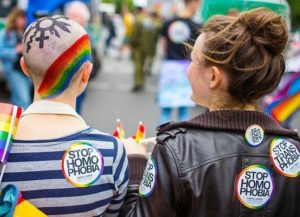
In June 2016, the first Dyke March takes place in Berlin. Approximately 1,500 women demonstrate on the eve of the Christopher Street Day parade in order to increase the visibility of lesbian women, who are largely ignored by the media, drowned out by their coverage of showy gays.68 The Dyke March was spearheaded by the publishers of the lesbian magazine L-MAG.69 At the same time, a familiar debate flares up again: homosexual women must organise themselves separately to gays because, as women, they have different political interests to homosexual men. The limits of the lesbian and gay alliance are discussed as well as the question of the absorption (and, ultimately, disappearance) of lesbians in the by now common term LGBTIQ (lesbian, gay, bisexual, trans, intersex, queer). L-MAG’s publisher Manuela Kay establishes: „LSBTI has failed as an attempt to involve all sexual identities within the community. The important positions and networks are firmly in the hands of gays.“70
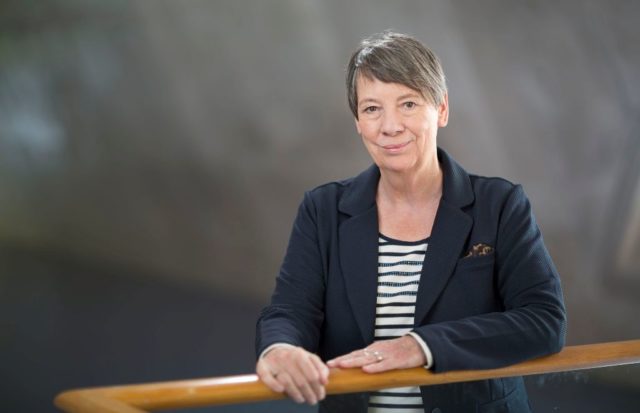
And EMMA declares: “Even in current party politics, the lesbian-gay conflict can be observed as if through a magnifiying glass. For example, when the chair of the Lesben und Schwulen in der Union (LSU) Jürgen Daenens marches alongside the so-called „pro-lifers“ at the Marsch der 1000 Kreuze.71
On 17 December 2013, Barbara Hendricks (SPD) is appointed Minister for the Environment and is thus Germany’s first openly homosexual minister.72
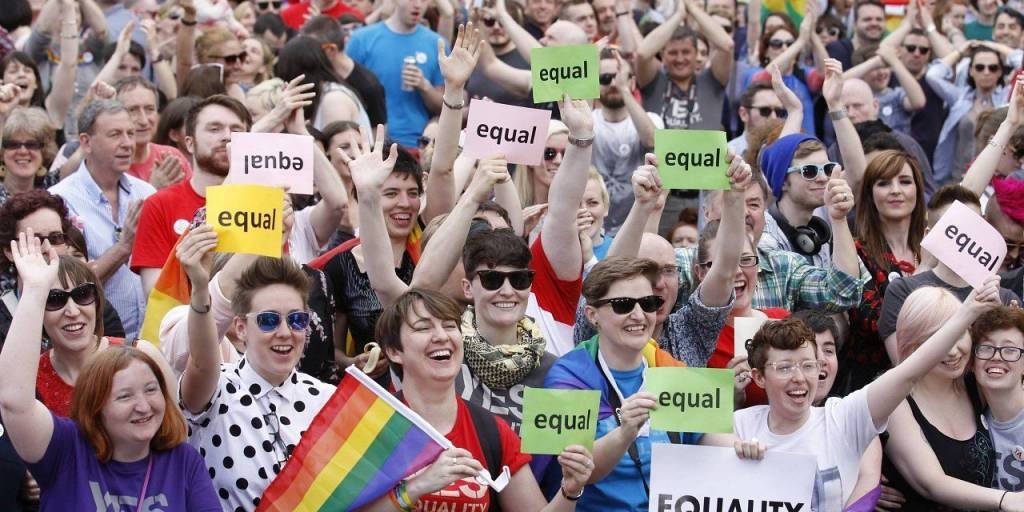
With a two-thirds majority, Ireland votes in favour of same-sex marriage in a referendum held on 22 May 2015.73 In Scandinavia, the Netherlands, Belgium, Luxembourg, Spain, and Portugal same-sex marriage is already legal. On 26 June 2015, the US Supreme Court also legalises same-sex marriage in a landmark civil rights ruling. It is deemed not right that same-sex couples are “excluded from one of civilization’s oldest institutions.“74
In June 2017 the Bundestag passes a law that legalises same-sex marriage. There is thus no difference in marriage law between heterosexual and homosexual couples. The law is passed with votes from all parties after Chancellor Merkel declares the vote to be a “matter of personal conscience” and a free vote within the CDU. The law on “marriage for all” comes into force in October 2017.75
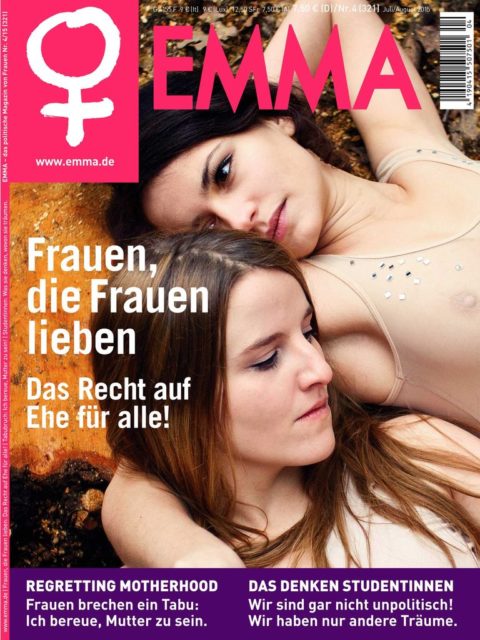
From a purely legal point of view, there is hardly any discrimination against homosexual women and men in Germany. However, half a century after the elimination of the taboo, the relationship between the heterosexual majority and homosexual minority is not totally free of tension. There is a factional dispute within lesbian and gay communities: is homosexuality innate or acquired? The feminist point of view is, roughly quoting Freud: humankind is inherently bisexual. Homosexuality and heterosexuality are cultural (and political!) categories.
References
1 Praunheim, Rosa von: Nicht der Homosexuelle ist pervers, sondern die Gesellschaft, in der er lebt (1970/1971). - BR, Germany, TV-Movie.
2 Kuckuc, Ina (1980): Der Kampf gegen Unterdrückung : Materialien aus der deutschen Lesbierinnenbewegung. - München : Frauenoffensive, p. 63. (FMT Shelf Mark: LE.11.163)
3 HAW-Frauen : Eine ist keine - Gemeinsam sind wir stark : Dokumentation (1974). - Homosexuelle Aktion West-Berlin Frauengruppe [ed.]. Berlin : HAW-Frauengruppe, S. 1. (FMT Shelf Mark: LE.11.025)
4 Ibid., p. 39.
5 Lesben in/und Bewegung : Materialien zur Lesbenbewegung (1989). - Frauenforschungs-, -bildungs- und -informationszentrum (FFBIZ) [ed.]. Berlin : Selbstverlag, S. 6. (FMT Shelf Mark: LE.11.067)
6 Rundbrief der Frauen der Lesbenpresse, 25.02.1975, see Pressedokumentation: Organisationen und Interessensvertretungen der Lesbenbewegung, 1973-1994. (FMT Shelf Mark: PD-LE.11.08, Kapitel 1, LAZ, Berlin)
7 Dennert, Gabriele, Leidinger, Christiane, Rauchut, Franziska (2007): Lesben in Wut : Lesbenbewegung in der BRD der 70er Jahre. - In: In Bewegung bleiben : 100 Jahre Politik, Kultur und Geschichte von Lesben. - Dennert, Gabriele [ed.] ; Leidinger, Christiane [ed.] ; Rauchut, Franziska [ed.]. Berlin : Querverlag, p. 46. (FMT Shelf Mark: LE.11.342)
8 HAW-Frauen : Eine ist keine - Gemeinsam sind wir stark : Dokumentation (1974). - Homosexuelle Aktion West-Berlin Frauengruppe [ed.]. Berlin : HAW-Frauengruppe, p. 9f.. (FMT Shelf Mark: LE.11.025)
9 Ibid, p. 33.
10 Sillge, Ursula (1991): Un-Sichtbare Frauen : Lesben und ihre Emanzipation in der DDR. - Berlin : Links, p. 89 f.. (FMT Shelf Mark: LE.11.203)
11 Ibid.
12 Ibid, p. 94 and p. 97.
13 Dennert, Gabriele, Leidinger, Christiane, Rauchut, Franziska (2007): „Wir sind keine Utopistinnen“ : Lesben in der DDR. - In: In Bewegung bleiben : 100 Jahre Politik, Kultur und Geschichte von Lesben. - Dennert, Gabriele [ed.] ; Leidinger, Christiane [ed.] ; Rauchut, Franziska [ed.]. Berlin : Querverlag, p. 99. (FMT Shelf Mark: LE.11.342)
14 Frau anders : Lesbenzeitschrift / Herausgeberin: Lesbengruppe im AK Homosexuelle Liebe, Evangelische Studentinnengemeinde Jena. - Jena: Nr. 1.1989 bis 4.1991. (FMT Shelf Mark: Z-L311)
15 HAW-Frauen : Eine ist keine - Gemeinsam sind wir stark : Dokumentation (1974). - Homosexuelle Aktion West-Berlin Frauengruppe [ed.]. Berlin : HAW-Frauengruppe, p. 29f.. (FMT Shelf Mark: LE.11.025) und Die Verbrechen an den lesbischen Frauen (1973). - Homosexuelle Aktion West-Berlin Frauengruppe [ed.], siehe Flugblatt im Bildarchiv (FMT Shelf Mark: FB.07.146) und An alle Frauen! (1973). - Homosexuelle Aktion West-Berlin Frauengruppe [ed.], siehe Flugblatt im Bildarchiv (FMT Shelf Mark: FB.07.145).
16 Kühn, Monne (2007): „Haut der geilen Männerpresse eine in die Fresse“. - In: In Bewegung bleiben : 100 Jahre Politik, Kultur und Geschichte von Lesben. - Dennert, Gabriele [ed.] ; Leidinger, Christiane [ed.] ; Rauchut, Franziska [ed.]. Berlin : Querverlag, p. 69. (FMT Shelf Mark: LE.11.342)
17 See Pressedokumentation: Mordprozess gegen Marion Ihns und Judy Andersen, 1973-1987. (FMT Shelf Mark: PD-LE.11.07, 1973)
18 HAW-Frauen : Eine ist keine - Gemeinsam sind wir stark : Dokumentation (1974). - Homosexuelle Aktion West-Berlin Frauengruppe [ed.]. Berlin : HAW-Frauengruppe, p. 30. (FMT Shelf Mark: LE.11.025)
19 Schwarzer, Alice (1974): Im Namen des gesunden Volksempfindens. - In: Konkret, Nr. 2, siehe Pressedokumentation: Chronik der Neuen Frauenbewegung, 1974. (FMT Shelf Mark: PD-FE.03.01-1974, Kapitel 3.1, 2)
20 Schleich, Barbara (1974): Protest beim Presserat. - In: Vorwärts, 12.09.1974. See Pressedokumentation: Chronik der Neuen Frauenbewegung, 1974. (FMT Shelf Mark: PD-FE.03.01-1974, Kapitel 3.1, 2)
21 Johnston, Jill (1973): Lesbian Nation: The Feminist Solution. - New York : Simon & Schuster.
22 Grimes, William (2010): Jill Johnston, Critic Who Wrote ‘Lesbian Nation’, Dies at 81. - In: The New York Times, 21.09.2010. Retreived from: www.nytimes.com/2010/09/21/arts/21johnston.html
23 Johnston, Jill (1977): Lesben-Nation : Die feministische Lösung. - Berlin : Amazonen-Frauenverlag. (FMT Shelf Mark: LE.11.072; various editions available)
24 HAW-Frauen : Eine ist keine - Gemeinsam sind wir stark : Dokumentation (1974). - Homosexuelle Aktion West-Berlin Frauengruppe [ed.]. Berlin : HAW-Frauengruppe, p. 39. (FMT Shelf Mark: LE.11.025)
25 Mengel, Monika (2007): Femø : Beginn einer lesbischen Zeitrechnung. - In: In Bewegung bleiben : 100 Jahre Politik, Kultur und Geschichte von Lesben. - Dennert, Gabriele [ed.] ; Leidinger, Christiane [ed.] ; Rauchut, Franziska [ed.]. Berlin : Querverlag, p. 72. (FMT Shelf Mark: LE.11.342)
26 Müthel, Eva (1973): Zärtlichkeit und Rebellion. - Germany, TV-Movie.
27 HAW-Frauen : Eine ist keine - Gemeinsam sind wir stark : Dokumentation (1974). - Homosexuelle Aktion West-Berlin Frauengruppe [ed.]. Berlin : HAW-Frauengruppe, p. 56ff. (FMT Shelf Mark: LE.11.025)
28 Siehe Pressedokumentation: Lesbische Frauen in der Öffentlichkeit I, 1966 - 1980. (FMT Shelf Mark: PD-LE.11.11, Kapitel 1973 u. 1974)
29 HAW-Frauen : Eine ist keine - Gemeinsam sind wir stark : Dokumentation (1974). - Homosexuelle Aktion West-Berlin Frauengruppe [ed.]. Berlin : HAW-Frauengruppe, p. 79ff.. (FMT Shelf Mark: LE.11.025)
30 Siegfried, Claus F. (1973): Und wir nehmen uns unser Recht! Lesbierinnen in Deutschland. - Germany, TV-Movie.
31 HAW-Frauen : Eine ist keine - Gemeinsam sind wir stark : Dokumentation (1974). - Homosexuelle Aktion West-Berlin Frauengruppe [ed.]. Berlin : HAW-Frauengruppe, p. 83ff. (FMT Shelf Mark: LE.11.025)
32 See Pressedokumentation: Chronik der Neuen Frauenbewegung, 1973. (FMT Shelf Mark: PD-FE.03.01-1973, Kapitel 3.2, 1)
33 Franke, Erika (1973): Besondere Kennzeichen : keine. - In: Stern, Nr. 48, p. 105, see Pressedokumentation: Lesbische Frauen in der Öffentlichkeit I, 1966-1980. (FMT Shelf Mark: PD-LE.11.11, 1973)
34 Internationales Lesbentreffen Pfingsten 1972, 1973, 1974, 1975 (1975). - Lesbisches Aktionszentrum (LAZ) [ed.]. Berlin : Selbstverlag, p.85. (FMT Shelf Mark: LE.11.023)
35 Kokula, Ilse (1983): Formen lesbischer Subkultur : Vergesellschaftung und soziale Bewegung. - Berlin : Verlag Rosa Winkel, p. 72. (FMT Shelf Mark: LE.11.162)
36 Hehsling, Ange, Michael, Caroline, Suder, Katrin, Taube, Paula, Rode, Tanja (2007): Immer noch und immer wieder : Das Lesbenfrühlingstreffen (LFT). - In: In Bewegung bleiben : 100 Jahre Politik, Kultur und Geschichte von Lesben. - Dennert, Gabriele [ed.] ; Leidinger, Christiane [ed.] ; Rauchut, Franziska [ed.]. Berlin : Querverlag, p. 244. (FMT Shelf Mark: LE.11.342)
37 Ibid, p. 245.
38 Beglaubigte Abschrift des Urteils des Landgerichts Itzehoe, see Pressedokumentation: Mordprozess gegen Marion Ihns und Judy Andersen, 1973-1987. (FMT Shelf Mark: PD-LE.11.07, 1974)
39 Hark, Sabine (1996): Magisches Zeichen : die Rekonstruktion der symbolischen Ordnung im Feminismus. - In: Grenzen lesbischer Identitäten : Aufsätze. - Hark, Sabine [ed.]. Berlin : Querverlag, p. 128. (FMT Shelf Mark: LE.11.139-a)
40 UKZ : Unsere kleine Zeitung von und für Lesben / ed.: Gruppe L 74 e.V. - Berlin : Richter : 1.1975 - 13.1987; 14.1988/89 - 27.2001,5 ; publication then discontinued. (FMT Shelf Mark: Z-L301)
41 Lesbenpresse / Lesbenpressenkollektiv im LAZ. - Berlin: 1.1975 - 11.1982; publication then discontinued. (FMT Shelf Mark: Z-L201)
42 Kokula, Ilse (1983): Formen lesbischer Subkultur : Vergesellschaftung und soziale Bewegung. - Berlin : Verlag Rosa Winkel, p. 76. (FMT Shelf Mark: LE.11.162)
43 Frauenliebe : Texte aus der amerikanischen Lesbierinnenbewegung (1975). - Lesbisches Aktionszentrum (LAZ) [ed.]. Berlin : Come-out-Lesbenverlag. (FMT-Signatur: LE.11.071; various editions available)
44 Bunch, Charlotte, Brown, Rita Mae (1975): Was jede Lesbierin wissen sollte. - In: Frauenliebe : Texte aus der amerikanischen Lesbierinnenbewegung. - Lesbisches Aktionszentrum (LAZ) [ed.]. Berlin : Come-out-Lesbenverlag, p. 124-131. (FMT Shelf Mark: LE.11.071-a)
45 Schwesternlust und Schwesternfrust : 20 Jahre Frauenbewegung (1981). - Schwarzer, Alice [ed.]. Köln : Emma-Frauenverlag, p. 90. (FMT Shelf Mark: FE.03.168-1991; various editions available)
46 Kokula, Ilse (1975): Internationales Lesbierinnentreffen in Amsterdam vom 7. Bis 9. März 75. - In: Unsere kleine Zeitung, Nr. 4, Mai 1975. See Pressedokumentation: Chronik der Neuen Frauenbewegung, 1975. (FMT Shelf Mark: PD-FE.03.01-1975, Kapitel 3.2, 16)
47 Schwarzer, Alice (1975): Die Heimlichtuerei macht einen kaputt. - In: Brigitte, Nr. 7. Siehe Pressedokumentation: Lesbische Frauen in der Öffentlichkeit I: 1966 - 1980. (FMT Shelf Mark: PD-LE.11.11, Kapitel 1975)
48 Schwarzer, Alice (1973): Der "kleine Unterschied" und seine großen Folgen : Frauen über sich : Beginn einer Befreiung. - Frankfurt am Main: Fischer-Taschenbücher. (FMT Shelf Mark: FE.10.226; various editions available)
49 Ibid, p. 205f..
50 Frauenprojekte (1976). - In: Unsere kleine Zeitung, Mai. Siehe Pressedokumentation: Chronik der Neuen Frauenbewegung, 1976. (FMT Shelf Mark: PD-FE.03.01-1976, chapter 3.2, 5)
51 Johnston, Jill (1977): Lesben-Nation : Die feministische Lösung. - Berlin : Amazonen-Frauenverlag. (FMT Shelf Mark: LE.11.072; various editions available)
52 Duc, Aimée (1976): Sind es Frauen? : Roman über das 3. Geschlecht. - Berlin: Amazonen-Frauenverlag. (FMT Shelf Mark: KU.03.DUC.001)
53 Die Flying Lesbians (1976). - In: Blatt, Nr. 72. Siehe Pressedokumentation: Chronik der Neuen Frauenbewegung, 1976. (FMT Shelf Mark: PD-FE.03.01-1976, chapter 3.2, 9)
54 See Pressedokumentation: Mordprozess gegen Marion Ihns und Judy Andersen, 1973-1987. (FMT Shelf Mark: PD-LE.11.07, 1976)
55 Vera Gaserow (1986): Judy Andersen in Dänemark begnadigt. - In: Die Tageszeitung, 08.07.1986. Siehe Pressedokumentation: Mordprozess gegen Marion Ihns und Judy Andersen, 1973-1987. (FMT Shelf Mark: PD-LE.11.07, 1986)
56 Dennert, Gabriele, Leidinger, Christiane, Rauchut, Franziska (2007): Lesben in Wut : Lesbenbewegung in der BRD der 70er Jahre. - In: In Bewegung bleiben : 100 Jahre Politik, Kultur und Geschichte von Lesben. - Dennert, Gabriele [ed.] ; Leidinger, Christiane [ed.] ; Rauchut, Franziska [ed.]. Berlin : Querverlag, p. 56. (FMT Shelf Mark: LE.11.342)
57 Faludi, Susan (2001): Am Anfang war eine Tunte. - In: EMMA, Nr. 4. Retrieved from: www.emma.de/lesesaal/45380
58 Satzung des Lesbenring e. V. in der Fassung vom 5. März 2005. Retrieved from: www.lesbenring.de/der-lesbenring/satzung/
59 Geschichte des Spinnboden. Retrieved from: www.spinnboden.de/wir/geschichte.html
60 Schwarzer, Alice (1984): Auch das noch?. - In: EMMA, Nr. 7, S. 23. Retrieved from: www.emma.de/lesesaal/45222
61 Die LuK. Retrieved from: www.lesben-und-kirche.de/luk.html
62 Barz, Monika, Leistner, Herta, Wild, Ute (1987): Hättest Du gedacht, daß wir so viele sind? : Lesbische Frauen in der Kirche. - Stuttgart : Kreuz-Verlag. (FMT Shelf Mark: LE.11.210)
63 Graupner, Helmut (2000): Von "widernatürlicher Unzucht" zu "sexueller Orientierung" : Homosexualität und Recht. - In: Que(e)rdenken : weibliche/männliche Homosexualität und Wissenschaft. - Hey, Barbara [ed.] ; Roth, Roswith [ed.] ; Pallier, Ronald [ed.]. Innsbruck : Studien-Verlag, p. 245. (FMT Shelf Mark: LE.11.310-a)
64 See Pressedokumentation: Lesbische Frauen in der Öffentlichkeit III, 1974-1994. (FMT Shelf Mark: PD-LE.11.13, Kapitel 3)
65 Aktion Standesamt - bundesweit (1992). - In: Unsere kleine Zeitung, Nr. 5, p. 12. (FMT Shelf Mark: Z-L301:1992-5)
66 Der lange, kurze Weg zur Homo-Ehe (2015). - In: EMMA, Nr. 4, S. 44. Retrieved from: www.emma.de/lesesaal/60369
67 Ungleichbehandlung von Ehe und eingetragener Lebenspartnerschaft im Bereich der betrieblichen Hinterbliebenenrente (VBL) verfassungswidrig (2009) und Ungleichbehandlung von Ehe und eingetragener Lebenspartnerschaft im Erbschaftsteuer- und Schenkungsteuergesetz verfassungswidrig (2010).
68 2013 - Wie alles anfing. - Dyke March Berlin. Retrieved from: dykemarchberlin.com/2013-2/
69 L.MAG : Das Magazin für Lesben. - Berlin: 2003 - . (FMT Shelf Mark: Z-L319)
70 Louis, Chantal (2015): Lesben tun sich zusammen. - In: EMMA, Nr. 4, p. 59. Retrieved from: www.emma.de/lesesaal/60369
71 Ibid.
72 „Ich wollte gar nicht die erste sein“ : Umweltministerin Barbara Hendricks im Interview (2017). - In: L.MAG : Das Magazin für Lesben, Jan./Feb., p. 42. (FMT Shelf Mark: Z-L319)
73 Gelassenes Irland (2015). - In: EMMA, Nr. 4, S. 43. Gelassenes Irland (2015). - In: EMMA, Nr. 4, p. 43. Retrieved from: www.emma.de/lesesaal/60369
74 Supreme Court legalisiert Homo-Ehe für alle. - Zeit online. Retrieved from: www.zeit.de/gesellschaft/zeitgeschehen/2015-06/hoechstes-us-gericht-erklaert-homo-ehe-landesweit-fuer-zulaessig
75 Schuler, Katharina (2017): Wie Merkel den Weg für die Ehe für alle frei machte. - In: Zeit Online, 27.06.2017. Retrieved from: www.zeit.de/politik/deutschland/2017-06/ehe-fuer-alle-cdu-csu-spd-bundestag-angela-merkel
Date of the last linkcheck: 05.09.2018
Selective Bibliography
Documents Online
Recommendations
Schwarzer, Alice (1973): Der "kleine Unterschied" und seine großen Folgen : Frauen über sich : Beginn einer Befreiung. - Frankfurt am Main: Fischer-Taschenbücher. (FMT-Signatur: FE.10.226; versch. Auflagen vorhanden)
HAW-Frauen : Eine ist keine - Gemeinsam sind wir stark : Dokumentation (1974). - Homosexuelle Aktion West-Berlin Frauengruppe [ed.]. Berlin : HAW-Frauengruppe. (FMT-Signatur: LE.11.025)
Frauenliebe : Texte aus der amerikanischen Lesbierinnenbewegung (1975). - Lesbisches Aktionszentrum (LAZ) [ed.]. Berlin : Come-out-Lesbenverlag. (FMT-Signatur: LE.11.071; versch. Auflagen vorhanden)
Internationales Lesbentreffen Pfingsten 1972, 1973, 1974, 1975 (1975). - Lesbisches Aktionszentrum (LAZ) [ed.]. Berlin : Selbstverlag. (FMT-Signatur: LE.11.023)
Kokula, Ilse (1975): Der Kampf gegen Unterdrückung : Materialien aus der deutschen Lesbierinnenbewegung. - München : Frauenoffensive. (FMT-Signatur: LE.11.163)
Johnston, Jill (1977): Lesben-Nation : Die feministische Lösung. - Berlin : Amazonen-Frauenverlag. (FMT-Signatur: LE.11.072; versch. Auflagen vorhanden)
Kokula, Ilse (1983): Formen lesbischer Subkultur : Vergesellschaftung und soziale Bewegung. - Berlin : Verlag Rosa Winkel. (FMT-Signatur: LE.11.162)
Barz, Monika, Leistner, Herta, Wild, Ute (1987): Hättest Du gedacht, daß wir so viele sind? : Lesbische Frauen in der Kirche. - Stuttgart : Kreuz-Verlag. (FMT-Signatur: LE.11.210)
In Bewegung bleiben : 100 Jahre Politik, Kultur und Geschichte von Lesben (2007). - Dennert, Gabriele [ed.] ; Leidinger, Christiane [ed.] ; Rauchut, Franziska [ed.]. Berlin : Querverlag. (FMT-Signatur: LE.11.342)
Jeffreys, Sheila (2011): Lesben in der Queer-Politik : ohne Zukunft. - Norderstedt : Books on Demand. (FMT-Signatur: LE.11.316[02])
Homosexualität_en : [an exhibition of the Deutsches Historisches Museum and the Schwules Museum* Berlin 26 June to 1 December 2015] (2015). - Bosold, Birgit [ed.] ; Brill, Dorothée [ed.] ; Weitz, Detlef [ed.]. Dresden : Sandstein-Verlag. (FMT-Signatur: LE.11.303)
FMT Press Documentation
Press Documention on female homosexuality: PDF-Download
The FMT press documentation is thematically structured and indexed. It comprises articles of the general public press, feminist press and other documents, such as leaflets and archival documents.
Selected FMT-Sources (lists)
Books and articles on female homsexuality at FMT: PDF-Download
Publications for Lesbians at FMT: PDF-Download
Related Topics
Law, Ruling and 'Male Justice'
Law, Ruling and 'Male Justice'
As the women’s movement got under way, law was almost exclusively administered by men. Feminists analyse that there is a “male justice” › mehr
Feminist Debates on Sexuality and Love
Feminist Debates on Sexuality and Love
It was the women’s movement that questioned the function of power in sexuality and unmasked the fact that love disguises power structures. › mehr
A More Female Church? Feminist Theology and Women in the Church
A More Female Church? Feminist Theology and Women in the Church
Women want to have a voice in the Church – and not only as members of the congregation, but in dialogue with God and all the way up to leading positions within the church hierarchy. › mehr


